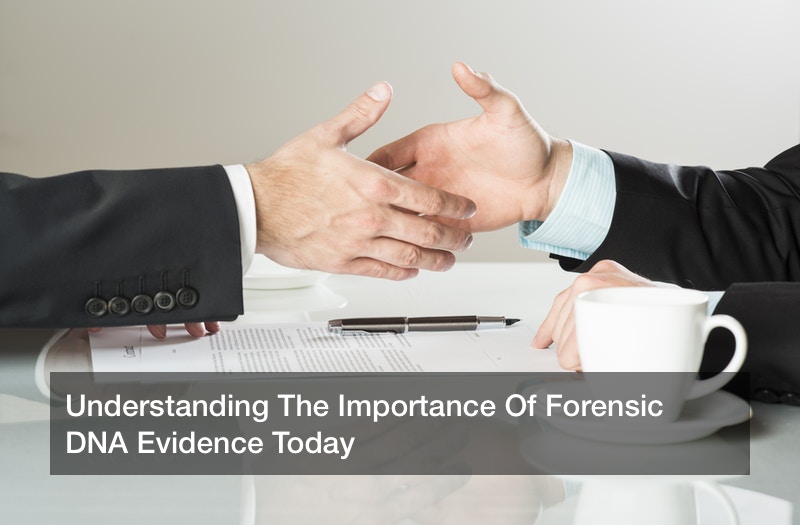
If you watch any type of procedural shows or true crime documentaries, you’ve probably heard about forensic DNA evidence. Often, it’s treated as a lynchpin of criminal cases, and something that can stand between a person being found innocent or guilty. It often is presented dramatically, at the last possible minute, and is seen as something that appears almost magically and is indisputable. In fact, there is a lot more to forensic DNA evidence than what initially meets the eye, and forensic DNA testing labs put a lot of work into finding that kind of evidence. Even then, it isn’t completely indisputable in a criminal case. There is a lot of work that goes into not just finding but understanding forensic DNA evidence. Though we often associate it with murder cases, as in recent years DNA evidence has been instrumental in exonerating prisoners wrongfully convicted of murder, it extends to a number of different types of criminal cases. DNA evidence ideally is found during the initial investigation, but that, unfortunately, does not always occur; and even when it is found, it often isn’t properly investigated.
With that being said, however, DNA evidence is also rather controversial. Forensic DNA testing labs must conduct themselves in a manner that is totally beyond reproach, as even a minor mistake made during the testing process can result in DNA evidence being thrown out entirely. Let’s look a bit more into the history of forensic DNA testing and understand how it has changed the way that criminal cases work today.
What Was Used Before Forensic DNA Testing Existed?
Before forensic DNA testing labs came into play, there were still similar types of forensic evidence brought into criminal cases. However, it was not as precise. DNA can narrow down a pool of suspects to one person, or at least a single family group from which an individual suspect can be found. But prior to that, there were markers that investigators would use to build cases and find suspects. The issue was that due to their impreciseness, errors were more common and in fact, the usage of some of these techniques has been used by criminal defense attorneys in order to have their clients exonerated or at least granted a new trial. For example, footprints were used to match a client’s shoes to a location. If investigators could identify the shoe brand and size that caused a footprint at a crime scene, they could attempt to match a suspect’s shoes to the footprint and use that as evidence against the suspect.
Perhaps more famously, dental records were often used to identify potential suspects, as well as victims in cases. Forensic DNA testing labs today are used to help match missing people to unidentified bodies, especially those that have undergone some degree of decomposition. This has led to a number of Jane and John Does being identified, some of which are victims of crimes and some of which are victims of circumstance and tragedy. Prior to DNA testing becoming prevalent, dental records were often relied upon to identify these unknown people. Dental records can be reliable, but not foolproof. Teeth can be damaged and degraded over the years, and some people have their DNA entered into certain databases but do not have their dental records properly recorded. Dental records were also used to identify suspects in some cases. For example, Ted Bundy was identified as a suspect in several murdered following the comparison of his distinct teeth to bite marks found on the victims. The issue, in this case, is that dental records and casts made of teeth are imperfect, and there is room for error. Room for error means many attorneys have called for some skepticism to be held towards dental records being used to convict an individual.
What Are Good Sources Of DNA Evidence?
Whenever DNA evidence is used in a criminal case, it needs to be solid evidence. Part of criminal defense law is focused on creating reasonable doubt, as prosecutors are required to prove criminal case defendants guilty beyond a reasonable doubt. Otherwise, a case can potentially be appealed down the road. For that matter, DNA evidence is important for defense attorneys attempting to prove that their clients could be innocent, but they must source their DNA evidence carefully in order to have it accepted by a judge and jury. Typically, the biological evidence that stands as good sources of DNA include blood, saliva, semen, urine, feces, hair, bones, tissue, and cells. But quite often, it can be difficult to source DNA like this directly, which means that it’s often picked up through evidence that has picked up DNA. It’s often up to investigators to carefully and rigorously examine seemingly untouched items for DNA. The amount of DNA left at a crime scene can be negligible, or otherwise quite surprisingly high. For example, a burglar could potentially leave behind DNA evidence without even realizing it simply by grazing a piece of furniture. Though it’s estimated that about 67% of burglaries could be avoided through the use of video surveillance, a lot of burglaries do still occur, and even when video surveillance is used DNA is often needed to determine the suspect’s identity definitively. Tools, gloves, hats, hats, and weapons are often used to pick up trace or contact DNA. At times, however, blood can be left on these types of items, as well as skin cells. Unfortunately, in many cases of sexual assault, the best source of DNA evidence is a sexual assault kit. This kit is used to pick up samples from the victim of the attack following the event. Similar collection procedures are often used following other violent attacks. The issue is often that these procedures are not followed correctly, which can compromise the DNA. On another note, though the aforementioned items and other items can be great sources of DNA evidence, at times they also only pick up trace amounts of DNA. These types of DNA could be argued to have been picked up during the crime; but they’re also so small that it could be argued that the person in question merely touched the item, outside of the crime, depending on the circumstances.
Is DNA Evidence Reliable?
The issue that investigators and prosecutors can run into is the integrity of the DNA evidence being used in a case. It’s incredibly important for DNA evidence to be upheld and maintained to the highest standards. This is why forensic DNA testing labs have endured some scrutiny in recent years. Some labs have been accused by defense attorneys of not properly transferring and storing DNA evidence, which means that they can become contaminated. It’s crucial that a reputable lab is used in every forensic investigation involving DNA. Contamination often occurs, however, before samples are sent to the lab. For example, a crime scene cleanup may occur too early, destroying or contaminating valuable evidence. Furthermore, while investigators are ideally trained to treat evidence carefully, some are more meticulous than others. For example, if a police officer touches a piece of evidence without wearing gloves, they could potentially contaminate it with their own DNA or even simply their own fingerprints. This is the type of moment that defense attorneys can latch onto.
In some cases, however, the issue lies within what happens after the DNA evidence is collected. Typically, DNA evidence is kept within sterile storage containers, and preserved within a temperature-controlled environment. However, issues can occur during the storage process, which can result in DNA evidence being rendered useless. Furthermore, if DNA evidence is not carefully tended to, it can actually become lost. While this may seem hard to believe, there have been cases in which DNA evidence is lost due to improper storage procedures. Samples must be labeled and locked away, especially if they are not visually distinct and therefore easily ruined. This is why the recent development of new types of DNA storage has made a major difference in the world of criminal investigation. One notable type of DNA storage, of course, is the genplate.
What Are Genplates?
Genplates remain a foreign concept to many, but they’ve become incredibly important to the DNA testing procedure. They are based on FTA-paper, and are used to bank both blood and other types of biological fluid. Typically, genplates can be used in automated processes used by forensic DNA testing labs as well, and are high density. Genplates are most often used to store dried blood spots, and preserve them over time. Dried blood spots are remarkably important during many criminal investigations but unfortunately can deteriorate quickly if not stores within genplates. Yet they hold an incredible amount of DNA evidence within just a small amount of material.
When the dried blood spots are stored within genplates, they must be stored in a humidity-controlled environment. Fortunes, genplates, when supplied by GenTegra, can come in conjunction with cabinets and and archives that provide active humidity control for their storage. To aid in the identification and organization of the samples, the genplates each have a specific barcode attached to them. Ultimately, it is much easier for forensic DNA testing labs to keep control over dried blood spots and other types of biological materials with the use of products like genplates.
How Has DNA Evidence Changed The Way Investigations Work?
Forensic DNA testing labs, and indeed DNA testing in general, has led to a number of different changes in the DNA testing process, as well as the commercial DNA landscape. DNA testing has become readily available to consumers, for both practical and entertainment purposes. For example, paternity tests are now available to buy individually, as are the ever-popular DNA test kits that trace an individual’s familial genetic history. Sometimes, forensic DNA testing labs handle these types of materials as well, as they do represent a commercial aspect of DNA testing that results in profits being made.
On a more serious level, forensic DNA testing labs represent a fundamental shift in terms of what juries expect in criminal cases today. Unfortunately, some very strong circumstantial criminal cases exist without good DNA evidence, and the prevalence of DNA testing on TV shows and movies has led some jurors to expect DNA evidence before they convict. A person can definitely be convicted of a crime without DNA evidence, but there is definitely a certain degree of security that sets in when DNA evidence is offered, and it can close a case much faster than it otherwise would be closed at times. And the commercial DNA testing industry is rapidly merging with forensic DNA testing. One recent case in which DNA proved crucial was that of Joseph Deangelo, otherwise known as the Golden State Killer. The Golden State Killer had gone unidentified for decades after he committed dozens of break-ins, sexual assaults, and murders. Though Joseph Deangelo became a suspect in recent years, the police did not have the evidence necessary to make an arrest until they were able to gain access to a commercial DNA testing bank, which had the DNA of one of Deangelo’s relatives on file. After obtaining this sample, the authorities were able to compare it to DNA evidence left behind by the Golden State killer. This evidence, in combination with circumstantial evidence, led authorities to arrest Deangelo, after which he ultimately pled guilty and was convicted of numerous crimes. In the face of the circumstantial evidence combined with the DNA evidence, even the best criminal law firms would have a hard time properly defending Deangelo.
There are a lot of reasons why DNA evidence needs to be regarded carefully. As defense lawyers will tell you, it is not infallible. It’s merely evidence that may or may not lead to the guilty party. In fact, a number of different errors can lead to some pieces of DNA evidence being outright misleading. The more you know about DNA evidence, however, the clearer it becomes that it is ultimately a valuable part of criminal investigations.









